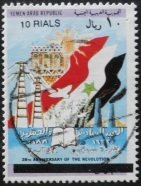Stamp: 26th Anniversary of the 29th September Revolution (Yemen 1993)
26th Anniversary of the 29th September Revolution (Yemen 1993)
01 January (Yemen ) within release Surcharged stamps Issue goes into circulation Stamp 26th Anniversary of the 29th September Revolution face value 10 Yemeni rial
| Stamp 26th Anniversary of the 29th September Revolution in catalogues | |
|---|---|
| Stamp Number: | Sn:YE 595 |
Stamp is vertical format.
Black surcharge 10 rials on 900 filsAlso in the issue Surcharged stamps Issue:
- Stamp - Int'l Campaign for the preservation of old Sana'a face value 8;
- Stamp - 26th Anniversary of the 29th September Revolution face value 10;
- Stamp - Immunisation, a chance for every child face value 10;
- Stamp - Coffee Beans face value 5;
- Stamp - International Youth Year face value 8;
- Stamp - Anniversary of 14th October Revolution face value 10;
- Stamp - 25th Anniversary of the Revolution face value 12;
- Stamp - Anniversary of Republic face value 10;
- Stamp - Anniversary of Republic face value 12;
- Stamp - Arab Scout Movement face value 10;
- Stamp - Arab Scout Movement face value 12;
- Stamp - Derrick and refinery face value 8;
- Stamp - First shipment face value 10;
- Stamp - Phone face value 8;
- Stamp - Sheeps face value 5;
- Stamp - Unity Agreement face value 12;
Stamp 26th Anniversary of the 29th September Revolution it reflects the thematic directions:
A flag is a piece of fabric (most often rectangular or quadrilateral) with a distinctive design that is used as a symbol, as a signaling device, or as decoration. The term flag is also used to refer to the graphic design employed, and flags have since evolved into a general tool for rudimentary signalling and identification, especially in environments where communication is similarly challenging (such as the maritime environment where semaphore is used). National flags are patriotic symbols with varied wide-ranging interpretations, often including strong military associations due to their original and ongoing military uses. Flags are also used in messaging, advertising, or for other decorative purposes. The study of flags is known as vexillology, from the Latin word vexillum, meaning flag or banner.
An oil well is a drillhole boring in Earth that is designed to bring petroleum oil hydrocarbons to the surface. Usually some natural gas is released as associated petroleum gas along with the oil. A well that is designed to produce only gas may be termed a gas well. Wells are created by drilling down into an oil or gas reserve and if necessary equipped with extraction devices such as pumpjacks. Creating the wells can be an expensive process, costing at least hundreds of thousands of dollars, and costing much more when in difficult-to-access locations, e.g., offshore. The process of modern drilling for wells first started in the 19th century but was made more efficient with advances to oil drilling rigs and technology during the 20th century.


